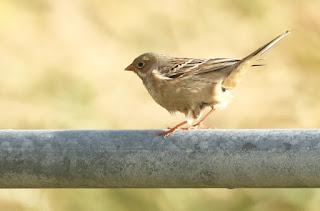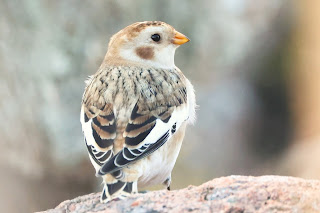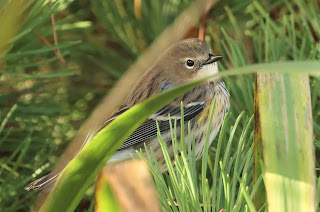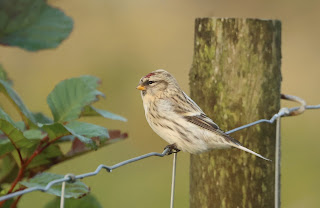Myself, six top birders and friends booked the trip last year. A group which included Patrick Earth, Gary Edwards, Damian Young, Ian Iggo, Rob Black and Dylan Edwards.
Bluethroat: From here we took the next ferry to Unit and joined a waiting crowd hoping to see the bluethroat which was first found in the garden of Alan Conlin's beautiful birders B&B at Haroldswick Bay.
Swainson's Thrush: We stayed in a really nice cottage near Eshaness, on the north western side of the island, overlooking a beautiful little bay filled with harbour seals and even otters!
Day one, we woke up to a pretty nice day on Shetland, clear, warm and calm. We decided to head over to Yell and then on to Unst. We soon connected with the Swainson's on Yell. A small American thrush who was sheltering in a garden of a cottage off the main road.
Day one, we woke up to a pretty nice day on Shetland, clear, warm and calm. We decided to head over to Yell and then on to Unst. We soon connected with the Swainson's on Yell. A small American thrush who was sheltering in a garden of a cottage off the main road.
We didn't have to wait long before it jumped out of the rose scrub and on to a post.
Ortolan Bunting: We dodged a few light showers as the weather changed and picked up twite and brambling in Haroldswick Bay's driveway before heading to Valyie where we scanned and worked over the hedgerows, the beach and scattered trees for a recently reported Ortolan, a new bird for me, and one I was keen to pick up.
Eventually Iggo found the bird as it flew in and landed close by. Although I was a little further up the track scanning through some scrub with Patrick, we heard an audible nod coming from behind us.
Ortolan Bunting: We dodged a few light showers as the weather changed and picked up twite and brambling in Haroldswick Bay's driveway before heading to Valyie where we scanned and worked over the hedgerows, the beach and scattered trees for a recently reported Ortolan, a new bird for me, and one I was keen to pick up.
Eventually Iggo found the bird as it flew in and landed close by. Although I was a little further up the track scanning through some scrub with Patrick, we heard an audible nod coming from behind us.
When we turned round we were thrilled to see the small moustached bunting bird foraging in the middle of the track.
Ortolan buntings are scarce passage visitor to the UK, typically during spring and autumn as birds make their way to tropical African areas to spend the winter.
Ortolan buntings are scarce passage visitor to the UK, typically during spring and autumn as birds make their way to tropical African areas to spend the winter.
Unfortunately these birds have long been considered a delicacy in France. It is now against the law to sell these birds, but not to eat them.
The bird was pretty jumpy and mobile and didn't really give itself up as easy as I was hoping. Still this was my first new lifer of the trip and bird I've been longing to see. A great way to end our first day here.
The bird was pretty jumpy and mobile and didn't really give itself up as easy as I was hoping. Still this was my first new lifer of the trip and bird I've been longing to see. A great way to end our first day here.
Felt like a bit of a slow bird day, but we had some lovely cake at a local community centre and good laughs throughout the day.
Yellow-browed Warbler: We were buzzing despite the Pechora's not being easy wasn't easy to pick up it did show on occasion and we all needed it, another lifer of the trip.
These are known as one of the Shetland Big Five, so we were definitely thrilled to have connected with one.
Lanceolated Warbler: Day four brought us another one of the Shetland Big Five, this time a Locustella warbler, a Lancy!
Lanceolated Warbler: Day four brought us another one of the Shetland Big Five, this time a Locustella warbler, a Lancy!
These small old world warblers of genus Locustella are small passerines that breed from northern Russia, through northern Asia to Japan, the migrate south and spend their winter in south east Asia.
But, every so often they come across and get blown on to Shetland. This bird was was found towards the end of the day in a small clump of iris and soft rush at Wester Quarff on the mainland.
When we arrived there were about 15 birders positioned carefully and at an appropriate viewing distance, I did hear that it came quite crowded after we left and there were some issues caused.
The bird was foraging along a damp ditch, periodically coming out into full view and peering out from behind the rush.
My third tick of the trip and a real Shetland speciality, with the majority of the records coming from Fair Isle so to get a showy mainland bird was a real treat.
Snow Bunting: The Shetland Big Five consist of Lancy, Siberian rubythraot, Pechora pipit, Pallas's Grasshopper Warbler (aka PG tips) and Siberian thrush. So having bagged two of the five already we were celebrating in the local curry house having a few beers.
Snow Bunting: The Shetland Big Five consist of Lancy, Siberian rubythraot, Pechora pipit, Pallas's Grasshopper Warbler (aka PG tips) and Siberian thrush. So having bagged two of the five already we were celebrating in the local curry house having a few beers.
The winds over night were particularly heavy and over the last few days had turned from an easterly direction to a strong westerly.
We started off at the the Eshaness Lighthouse were we picked up a trio of snow bunting. Later in the week there were over 40 snow bunts seen in this area and we also picked one up on a trip up Ronas Hill.
We started off at the the Eshaness Lighthouse were we picked up a trio of snow bunting. Later in the week there were over 40 snow bunts seen in this area and we also picked one up on a trip up Ronas Hill.
Snow Buntings: The weather changes so quickly up here, one minute its dark and overcast with rollin could and rain, the next it's sunny and mild. I was forever too warm with too many layers on.
This part of the island is lovely, the lighthouse is on the north west coast of mainland Shetland perched atop some of the most dramatic cliffs and coastal scenery in the UK. The area is one of the top attractions for visitors and locals alike with breathtaking open views in every direction and the some great Shetland scenery.
Yellow-rumped Warbler: Later that day news broke of a yellow-dumped warbler (aka Myrtle warbler) and American warbler and only my 2nd UK bird after the 2014 Durham bird, so with some haste we headed over there.
The bird was tricky to see upon arriving, the gathering crowds tried their best not to block the road and were curious to the neighbouring farmer and were pacing enough to allow the bird to forge normally.
We went back the next day and the bird was showing even better as the winds eased, the bird even dropped onto the leaf litter and began foraging on the deck juts a few feet away from us, we were astonished.
The bird was very confiding and didn't seemed fussed about the torrent of machine gun camera shutters sounding off as it foraged in the leaf litter.
Smart looking birds, who in their native north America prefer conifer woodland and edges of wooded scrub areas, but being one of the most widespread American warblers they are found almost everywhere.
Homeyer's Great Grey Shrike: The day ended back at Hillswick, as its pretty close to our cottage were often stoped here either in the mornings or evening to check out the waders in the short grazed fields and the area close to the iris beds.
It is in this area that the great grey shrike made its home, it was here from the day we arrived. Some folk were getting pretty excited over this bird as if its confirmed, and its looks likely it would come from the 'homeyeri' race and if so it would be a possible first for the UK.
Yellow-browed Warbler: Day seven and this was our final day on Shetland and news broke of another Myrtle warbler in the small valley as the first one, this one being a more strikingly marked individual I was keen to go right away.
Yellow-rumped Warbler: However living in a democracy we decided to do some birding at Kergord Woods to try and find something good, we managed a couple of YBW's and a black cap. Not much to write home about.
So we moved on to the 2nd Myrtle warbler of the week! And now I was under a time limit, we were due to fly off around 4 o'clock.
This part of the island is lovely, the lighthouse is on the north west coast of mainland Shetland perched atop some of the most dramatic cliffs and coastal scenery in the UK. The area is one of the top attractions for visitors and locals alike with breathtaking open views in every direction and the some great Shetland scenery.
Yellow-rumped Warbler: Later that day news broke of a yellow-dumped warbler (aka Myrtle warbler) and American warbler and only my 2nd UK bird after the 2014 Durham bird, so with some haste we headed over there.
The bird was tricky to see upon arriving, the gathering crowds tried their best not to block the road and were curious to the neighbouring farmer and were pacing enough to allow the bird to forge normally.
We went back the next day and the bird was showing even better as the winds eased, the bird even dropped onto the leaf litter and began foraging on the deck juts a few feet away from us, we were astonished.
The bird was very confiding and didn't seemed fussed about the torrent of machine gun camera shutters sounding off as it foraged in the leaf litter.
Smart looking birds, who in their native north America prefer conifer woodland and edges of wooded scrub areas, but being one of the most widespread American warblers they are found almost everywhere.
Homeyer's Great Grey Shrike: The day ended back at Hillswick, as its pretty close to our cottage were often stoped here either in the mornings or evening to check out the waders in the short grazed fields and the area close to the iris beds.
It is in this area that the great grey shrike made its home, it was here from the day we arrived. Some folk were getting pretty excited over this bird as if its confirmed, and its looks likely it would come from the 'homeyeri' race and if so it would be a possible first for the UK.
Yellow-browed Warbler: Day seven and this was our final day on Shetland and news broke of another Myrtle warbler in the small valley as the first one, this one being a more strikingly marked individual I was keen to go right away.
Yellow-rumped Warbler: However living in a democracy we decided to do some birding at Kergord Woods to try and find something good, we managed a couple of YBW's and a black cap. Not much to write home about.
So we moved on to the 2nd Myrtle warbler of the week! And now I was under a time limit, we were due to fly off around 4 o'clock.
after wading through a boggy field we eventually made it to the bird, where also Paul Baker was, the bird showed extremely well is only for a short time (which is all I had) and it was nice to say my fair well's to Paul before heading to the airport.
Now this is where our trip take a turn for the worse as unbeknown to me, as I was watching films on my I pad sat in my seat on the plane ready to go that a Least bittern was found not far from the airport. A LEAST BITTERN, A FSRT FOR THE UK!!!
Now this is where our trip take a turn for the worse as unbeknown to me, as I was watching films on my I pad sat in my seat on the plane ready to go that a Least bittern was found not far from the airport. A LEAST BITTERN, A FSRT FOR THE UK!!!
Mealy Redpoll: It was only during the flight when Dylan am walking down the aisle toward me looking glum and said 'Least bittern' my face dropped, we had just missed it by minutes before taking off.
Paul Baker's partner Charlie was taking a stroll around the beach when she stumbled upon it and txted Paul who rushed over and confirm the ID.
King Eider: We were thrilled for Paul and Charlie, these type of finds are what dreams are made of and we were quick to drop them a call in the airport to congratulate them.
King Eider: We were thrilled for Paul and Charlie, these type of finds are what dreams are made of and we were quick to drop them a call in the airport to congratulate them.
As for the bittern unfortunately its passed away in the night, after it was taken into care. I won't comment on here about the type of care the bird received and the reasons why it was picked or the box. But the set of circumstances are questionable.
Barred Warbler: Shetland was superb, four lifers for me and a couple of extra for the rest of the crew and some really good memories, ww will be back next year.
Barred Warbler: Shetland was superb, four lifers for me and a couple of extra for the rest of the crew and some really good memories, ww will be back next year.



































